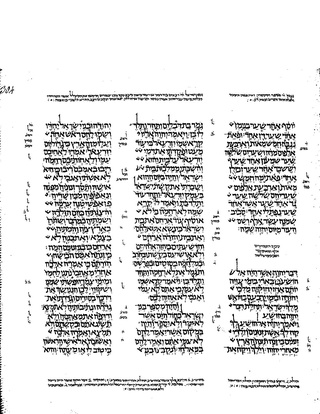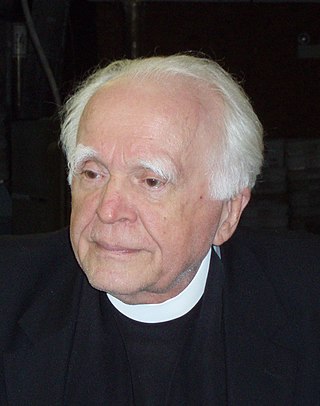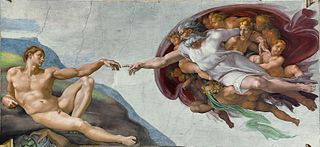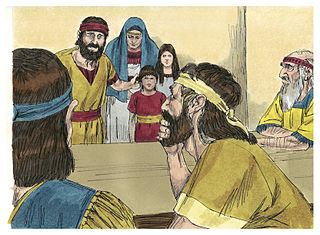This article needs additional citations for verification .(January 2015) |
The Book of Genesis has been interpreted in many ways, including literally, religiously, and allegorically.
This article needs additional citations for verification .(January 2015) |
The Book of Genesis has been interpreted in many ways, including literally, religiously, and allegorically.
The Book of Genesis is regarded as a religious text by several faiths, including Judaism, Christianity, and Islam. Many adherents of those faiths interpret Genesis literally, while others interpret it as a metaphor or symbolism. Joseph Ratzinger, who would later become Pope Benedict XVI, articulates a Roman Catholic perspective, rejecting a literalism that would see Genesis interpreted as speaking about reality like “physics and biology.” [1] Rejecting an approach that would, in his mind, by emphasising only the general messages of the text “imply that the individual passages of the Bible sink into meaninglessness,” [1] he presents a symbolic hermeneutic for the text.
"They represent truth in the way that symbols do — just as, for example, a Gothic window gives us a deep insight into reality, thanks to the effects of light that it produces and to the figures that it portrays." [2]
Ratzinger brings specific attention to the numerology of the narrative, finding echoes for the Ten Commandments and the Sabbath, drawing out an under girding message of the inherent nature of the creation to worship, as per the Ten Commandments, and to do so rhythmically, as per the Sabbath. [3]
The Book of Genesis is considered by many to be an allegorical source of morality and ethics. A readily available example of this is an allegorical interpretation the book's description of days passing during creation. [4] An allegorical conclusion of the passage may conclude that these were not 24-hour periods because stars were only created on the fourth day. A 'phase' interpretation as the one described is commonly used as the basis for Old Earth creationism
The Book of Genesis is often interpreted to be a factual and historical account of how the earth was created by the Judeo-Christian-Islamic God, and the earliest accounts of mankind. Groups such as Answers in Genesis and individuals such as Ken Ham and Kent Hovind use this belief to critique modern scientific theories regarding evolution, the age of the Earth, and various aspects of physical cosmology.
The Book of Genesis is interpreted as a collection of various documents that were written by different people at different times and were collected, translated, and edited by several editors at different times centuries later. Each editor, working from what to them were ancient source documents, combined material, omitted other material, added glosses and made changes to parts they believed were errors.
Looking past historical critical concerns, such as the compositional history of the text, this approach is instead based on the following assumptions: [5]
1. The Genesis text analyzed is the current traditional manuscript.
2. The text, for the purpose of literary analysis, is regarded as having been written by an "author" who is responsible for the final version of the text. The literary reading, therefore, relates to what is expressed in the current form of the text, assuming its unity.
3. The text is examined as a narrative free of prejudices about its assumed literary nature or religious orientation. God, therefore, is but a literary persona in it.
4. Analysis of the protagonists and their acts are carried out with no prejudices about an assumed cultural 'Sitz im Leben'.

The Book of Zephaniah is the ninth of the Twelve Minor Prophets of the Old Testament and Tanakh, preceded by the Book of Habakkuk and followed by the Book of Haggai. Zephaniah is a male given name that is usually interpreted to mean "Yahweh has hidden/protected," or "Yahweh hides". The church father Jerome of Stridon interpreted the name to mean "the watchman of the Lord". The original text of the prophecy was written in Biblical Hebrew.
The Book of Genesis is the first book of the Hebrew Bible and the Christian Old Testament. Its Hebrew name is the same as its first word, Bereshit. Genesis is an account of the creation of the world, the early history of humanity, and the origins of the Jewish people.

The Rapture is an eschatological position held by some Christians, particularly those of American evangelicalism, consisting of an end-time event when all dead Christian believers will be resurrected and, joined with Christians who are still alive, together will rise "in the clouds, to meet the Lord in the air."
Premillennialism, in Christian eschatology, is the belief that Jesus will physically return to the Earth before the Millennium, heralding a literal thousand-year messianic age of peace. Premillennialism is based upon a literal interpretation of Revelation 20:1–6 in the New Testament, which describes Jesus's reign in a period of a thousand years.
The Genesis creation narrative is the creation myth of both Judaism and Christianity. The narrative is made up of two stories, roughly equivalent to the first two chapters of the Book of Genesis. In the first, Elohim creates the heavens and the Earth in six days, then rests on, blesses, and sanctifies the seventh. In the second story God creates Adam, the first man, from dust and places him in the Garden of Eden. There he is given dominion over the animals. Eve, the first woman, is created from Adam's rib as his companion.

Biblical inspiration is the doctrine in Christian theology that the human writers and canonizers of the Bible were led by God with the result that their writings may be designated in some sense the word of God. This belief is traditionally associated with concepts of the biblical infallibility and the internal consistency of the Bible.
James Douglas Grant Dunn, also known as Jimmy Dunn, was a British New Testament scholar, who was for many years the Lightfoot Professor of Divinity in the Department of Theology at the University of Durham. He is best known for his work on the New Perspective on Paul, which is also the title of a book he published in 2007.

Stanley L. Jaki was a Hungarian-born priest of the Benedictine order. From 1975 to his death, he was Distinguished University Professor at Seton Hall University, in South Orange, New Jersey.

Genesis 1:2 is the second verse of the Genesis creation narrative. It is a part of the Torah portion Bereshit.

Allegorical interpretations of Genesis are readings of the biblical Book of Genesis that treat elements of the narrative as symbols or types, rather than viewing them literally as recording historical events. Either way, Judaism and most sects of Christianity treat Genesis as canonical scripture, and believers generally regard it as having spiritual significance.

Richard John Bauckham is an English Anglican scholar in theology, historical theology and New Testament studies, specialising in New Testament Christology and the Gospel of John. He is a senior scholar at Ridley Hall, Cambridge.
Covenantal theology is a distinctive approach to Catholic biblical theology stemming from the mid-twentieth century recovery of Patristic methods of interpreting scripture by scholars such as Henri de Lubac. This recovery was given further impetus by Dei verbum, the Second Vatican Council's "Dogmatic Constitution on Divine Revelation", and consolidated in the section on scripture Catechism of the Catholic Church. These developments gave rise to an approach that emphasizes the "four senses" of scripture within a framework that structures salvation history via the biblical covenants, in combination with the techniques of modern biblical scholarship.

The framework interpretation is a description of the structure of the first chapter of the Book of Genesis, the Genesis creation narrative. Biblical scholars and theologians present the structure as evidence that Gen. 1 presents a symbolic, rather than literal, presentation of creation.
Luke Timothy Johnson is an American New Testament scholar and historian of early Christianity. He is the Robert W. Woodruff Professor of New Testament and Christian Origins at Candler School of Theology and a Senior Fellow at the Center for the Study of Law and Religion at Emory University.

"Thou shalt not take the name of the LORD thy God in vain" is the second or third of God's Ten Commandments to man in Judaism and Christianity.

Micah 2 is the second chapter of the Book of Micah in the Hebrew Bible or the Old Testament of the Christian Bible. This book contains the prophecies attributed to the prophet Micah, and is a part of the Book of the Twelve Minor Prophets.

Nehemiah 10 is the tenth chapter of the Book of Nehemiah in the Old Testament of the Christian Bible, or the 20th chapter of the book of Ezra-Nehemiah in the Hebrew Bible, which treats the book of Ezra and the book of Nehemiah as one book. Jewish tradition states that Ezra is the author of Ezra-Nehemiah as well as the Books of Chronicles, but modern scholars generally accept that a compiler from the 5th century BCE known as The Chronicler is the final author of these books. The chapter contains the list of signatories to the people's pledge and the later part deals with intermarriage with the non-Jews among the "people of the land" punctuated with the pledge to separate from "foreigners".

1 Samuel 28 is the twenty-eighth chapter of the First Book of Samuel in the Old Testament of the Christian Bible or the first part of the Books of Samuel in the Hebrew Bible. According to Jewish tradition the book was attributed to the prophet Samuel, with additions by the prophets Gad and Nathan, but modern scholars view it as a composition of a number of independent texts of various ages from c. 630–540 BCE. This chapter contains the account of David's escape from Saul's repeated attempts to kill him. This is within a section comprising 1 Samuel 16 to 2 Samuel 5 which records the rise of David as the king of Israel.

1 Samuel 29 is the twenty-ninth chapter of the First Book of Samuel in the Old Testament of the Christian Bible or the first part of the Books of Samuel in the Hebrew Bible. According to Jewish tradition the book was attributed to the prophet Samuel, with additions by the prophets Gad and Nathan, but modern scholars view it as a composition of a number of independent texts of various ages from c. 630–540 BCE. This chapter contains the account of David's escape from Saul's repeated attempts to kill him. This is within a section comprising 1 Samuel 16 to 2 Samuel 5 which records the rise of David as the king of Israel.

1 Samuel 31 is the thirty-first chapter of the First Book of Samuel in the Old Testament of the Christian Bible or the first part of the Books of Samuel in the Hebrew Bible. According to Jewish tradition, the book was attributed to the prophet Samuel, with additions by the prophets Gad and Nathan, but modern scholars view it as a composition of a number of independent texts of various ages from c. 630–540 BCE. This chapter contains the account of Saul's repeated attempts to kill him. This is within a section comprising 1 Samuel 16 to 2 Samuel 5 which records the rise of David as the king of Israel.